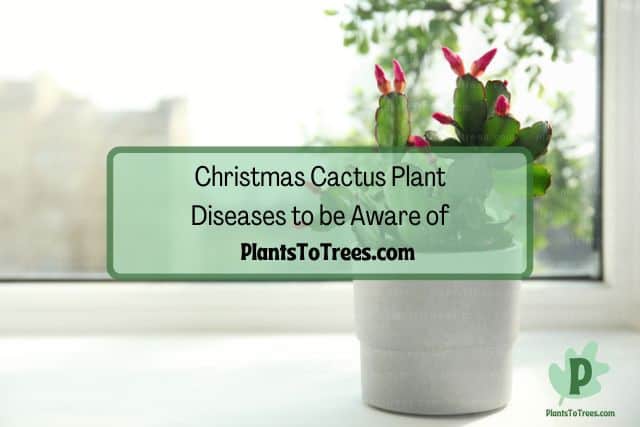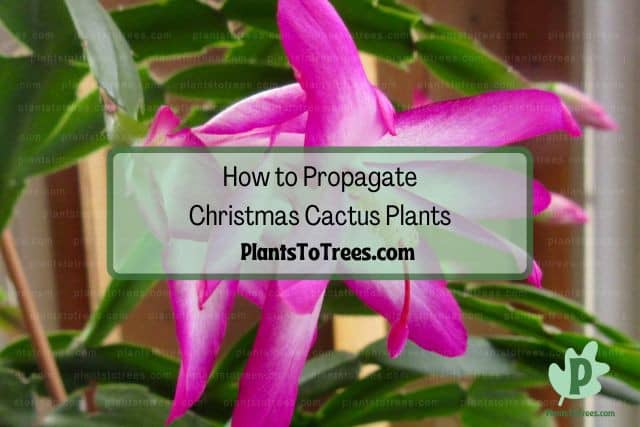The Christmas Cactus plant is a popular holiday plant due to its vibrant flowers. While it has cactus in its name, that can be a little bit deceiving. A Christmas Cactus plant is not technically a cactus. It is actually a tropical plant that grows in the decaying top covering of tropical forests. Because of this, it is not as adaptable to arid conditions as typical cacti.

When caring for a Christmas Cactus plant sticking to a regular watering schedule that prevents both overwatering and underwatering is essential. If you want your Christmas Cactus to bloom year-round you also need to provide fertilization and specific lighting.
When cared for properly, Christmas Cactus plants make for easy to care for house plants. When they bloom the contrast of their bright flowers against the deep green of their leaves and stems is stunning.
If you want your Christmas Cactus plant to flourish, there are a few steps that you need to take to ensure that your plant is in the right conditions.
Other Names of Christmas Cactus
Depending on where you live in the world, you might have a different name for common plants. The majority of plants are known by several names. Knowing which plant it is that you are looking for can help when seeking out new plants or advice.
The scientific name of the Christmas Cactus plant is Schlumbergera. You can also find the Christmas Cactus plant referred to as the Thanksgiving cactus, crab cactus, or holiday cactus.
Frost Tolerance and USDA Hardiness Zones of Christmas Cactus Plants
The USDA hardiness zone classifies plants depending on the average minimum temperature that your species of plant can continue to survive in. While the hardiness zone is aimed at predicting how plants will flourish in an outside setting, the temperature requirements can also help you determine where in your house you want to place your plant.
The Christmas Cactus plant has a USDA hardiness zone of nine to 11. While they can withstand colder temperatures, they are still tropical plants and will not withstand frost. The ideal temperature range for your Christmas Cactus plants is between 60 to 65°F.
If you are planting your Christmas Cactus plants outside and live in an area that reaches temperature levels low enough to frost and freeze – you need to plan out the timing of your planting. If you have indoor Christmas Cactus plants it’s important to keep your plants in an area that is not directly in front of an air conditioning vent.
There is an exception when it comes to the temperature levels for your Christmas Cactus plant. If you want it to bloom year-round, it needs to be exposed to colder temperatures. This is because of the temperature drop of when it would naturally bloom in its environment. To encourage blooms keep your plant at around 50°F. Once your blooms begin to develop, you can move your plant back to a warmer area.
How Many Hours of Sunlight Does Christmas Cactus Plant Need?

The direction of your garden or the windows in your home help determine where you should place your plant. To flourish, plants need a certain amount of darkness and sunlight to promote their growth. If you select an area that does not receive enough hours of either, your plant will have stunted growth and eventually die.
The Christmas Cactus needs at least eight to twelve hours of sunlight. The only exception to this is if you are trying to encourage your plant to grow blooms in the off-season. Then your Christmas Cactus needs longer periods of darkness to simulate its natural conditions.
Christmas Cactus Plants Needs Direct or Indirect Sunlight?

The level of sunlight that you expose your plants to is one of the most important factors. Too much sunlight and you will scorch your plant, but too little sunlight can cause stunted growth and wilt. When selecting an area outside to plant or where to place your potted plant indoors you need to consider the level of sunlight and how many hours of sunlight that spot gets in a day.
The Christmas Cactus plant should be in indirect sunlight. They do well in both medium to bright indirect sunlight. Just be sure that the leaves do not appear to be drying out or browning. Selecting a south-facing spot is the best way to make your Christmas Cactus plant thrive.
If you are attempting to make your Christmas Cactus plant bloom in the off-season, you need to change its lighting. To imitate the conditions that your plant would experience in its natural habitat around the time when it blooms, you need to keep it in dim to dark conditions.
This will trick your plant into thinking that it’s the winter season and it will start producing blooms. You should keep it in this lighting for at least 12 to 14 hours a day. However, your plant should not be completely devoid of light, you want to make sure it gets indirect and medium light for the rest of the time until you notice it has begun to flower.
Is Christmas Cactus Plant an Indoor, Outdoor Plant, or Both?

There are plenty of plants that you can grow indoors as well as outdoors. What it comes down to is the hardiness of the plant and the environmental conditions that it can survive in. If you live in cooler climates, many popular houseplants cannot also survive in your outdoor garden.
The Christmas Cactus can be both an indoor and outdoor plant, but it all depends on where you live. As it is a tropical plant, it prefers humid and warm environments. It does have a higher tolerance to cold than many other types of cactus. When growing it as an indoor plant it is easy to care for and can bloom year-round.
What are the Lighting Requirements for Indoor Christmas Cactus Plants?
The key to growing indoor plants is to find the perfect balance between sunlight and the setup of your home. All plants have different lighting requirements. Choosing the right plant for the amount of light and the direction that your windows face in your home is essential if you want to prevent your plants from being stunted or dying.
The lighting requirements for a Christmas Cactus houseplant are indirect sunlight. They can handle both bright and medium indirect sunlight, but if you put it in a spot that gets full sun, your plant will die. They can also survive in dim lighting conditions.
While the Christmas Cactus plant only blooms once a year when in its natural habitat, there are a few tricks that you can do to make your plant bloom year-round. One of which is moving it to a cooler and darker environment until you begin to see flower buds forming.
What Soil Requirements Do Christmas Cactus Plants Need?
The soil that you pot your Christmas Cactus plant in plays a bigger role than you may think. Your soil is a key source of nutrition in the growth of your plants. You want a mix that has the right consistency and mineral content to support healthy growth in your Summer Cactus plant.
Christmas Cactus plants need a mix of soil that promotes drainage. Otherwise, with moisture-absorbing soil, you run the risk of root rot. To meet the soil requirements of your Christmas Cactus plant you can either purchase a soil blend from your local home improvement store that is designed for cacti.
If you’d rather blend your own mix of soil you want to mix three parts of potting soil with one part of Perlite. Make sure that you plant your Christmas Cactus in a pot that has proper drainage. You want to be sure that your soil can dry out fully between watering periods.
How Much Water Does Christmas Cactus Plant Need?

Because Christmas Cactus plants are not your typical cactus plants, it can be difficult to determine how frequently you should water them. While Christmas Cactus plants are easy to care for, it can be easy to overwater or underwater your Christmas Cactus plant.
Your Christmas Cactus plant should be watered every two to three weeks. You want to give it enough water that the soil is damp, but not saturated. In between watering, wait until the soil has dried out, otherwise, you run the risk of root rot.
When watering your Christmas Cactus plant be sure to water it at the base of the plant. Watering the leaves or stem directly can lead to stem rot.
Is My Christmas Cactus Plant Overwatered? What Are the Symptoms?
One of the things that makes Christmas Cactus plants so easy to care for is that they don’t need much maintenance. That includes infrequent watering. If you water your Christmas Cactus plant too often, you’ll notice that your plant will start to suffer.
If your Christmas Cactus is overwatered you will first notice your leaves changing color. They will begin to yellow as they become oversaturated. While they are tropical plants, they aren’t plants that absorb high amounts of moisture frequently.
If you let your Christmas Cactus plant sit in water for long periods of time, or water your plant so often that the soil is always damp to the touch, you’ll notice your plant slowly starting to die. Your leaves will not only be yellow, but they will also become rubbery and weak.
The causes behind this issue can either be root or stem rot. If not addressed right away, both root and stem rot will end up killing your Christmas Cactus plant.
Is My Christmas Cactus Plant Underwatered? What Are the Symptoms?
While Christmas Cactus plants have cactus in their name, they aren’t like their desert counter-named plants. They are tropical plants and require water to flourish. If your Christmas Cactus plant is underwatered there are some common signs that you will notice.
You will be able to tell if your Christmas Cactus is underwatered if the stem and leaves of the plant begin to change in appearance. Your Christmas Cactus plant’s leaves will begin to shrivel. Your plant’s roots are attempting to absorb any moisture that can keep the plant alive.
As a result, Christmas will sabotage itself by taking moisture from the stem and leaves of your plant. When underwatering becomes severe the leaves on your plant will become brittle to the touch and break off.
When it comes to watering your Christmas Cactus plant, a good rule of thumb is to water when the soil feels completely dry to the touch.
This gives your plant enough time to fully absorb water and prevent overwatering.
How Much Fertilizer Does Christmas Cactus Plant Need?

Fertilization is an essential part of making your Christmas Cactus plant flourish. Christmas Cactus plants are also unique in the sense that you can get them to produce cactus flowers year round. To do this though you need the right conditions and nutrition for your Christmas Cactus plant’s soil.
Your Christmas Cactus plant needs either a houseplant bloom fertilizer or a water-soluble fertilizer in a 20-10-20 mix. You don’t need to fertilize your Christmas Cactus plant often, if you do it once monthly you will get the best results for the Christmas Cactus plant.
When fertilizing your Christmas Cactus plant you want to do it at the same time as when you are watering your plant. This allows the fertilizer to be absorbed into the soil and slowly into your plant’s roots. If you want to further strengthen your Christmas Cactus plant, you can additionally add a teaspoon of Epson salts, per gallon of water, to add needed minerals.
If you’re trying to get your Christmas Cactus to flower year-round, in addition to lighting conditions, in the summer months you can use a delayed release plant food with elevated levels of phosphate.
When it comes to fertilizing your Christmas Cactus plant, if you stop fertilizing it you won’t see as many blooms. To have your Christmas Cactus plant flourish year-round your plant will need added nutrients to give it a little bit of encouragement to continue to flourish year-round.
While fertilizer can provide your plant with much-needed nutrients, like with all good things, you may end up overdoing it. Make sure to read the instructions on your different fertilizers and remember that you only want to do it once a month.
Christmas Cactus Plant Diseases to be Aware of

Both indoor and outdoor plants are susceptible to diseases. These diseases can cripple and kill your plants if not treated properly. When it comes to some plant diseases, taking the steps to stop them before they begin is essential in making sure that your plants will flourish. The Christmas Cactus is no different, there are diseases that your Christmas Cactus plant may fall prey to.
The main Christmas Cactus disease that you should be aware of is rot. Your Christmas Cactus plant is prone to Basel stem rot as well as root rot. If your Christmas Cactus plant is overwatered or kept in damp conditions, your roots will suffer from rot.
The Christmas Cactus is part of a unique collection of tropical plants. They grow just above the soil in the damp tropical decaying foliage that covers the forest floor. When your Christmas Cactus is in soil, it can be easy to experience root rot. If you’re keeping your soil wet at all times, that added insulation from the soil will prevent your Christmas Cactus plants’ roots from being able to dry out.
Your Christmas Cactus may also experience stem rot. Although the Christmas Cactus is not a traditional cactus, it still should not be watered directly on its stems. Overwatering and watering frequently on the stems of your Christmas Cactus plant will lead to rot. Christmas Cactus plants shouldn’t be watered daily, you want to allow the soil and the plant a chance to dry out before you water them again.
We at Plants To Trees first published this article on August 23, 2022. Copyright protected.
While the Christmas Cactus plant is native to tropical regions, the dispersion of moisture and the way that the plant grows helps the plant grow sturdy and less likely to suffer from root or stem rot.
Are There Different Types of Christmas Cactus Plants?
When you have different types of the same plant, you’ll notice that there are different growing times and rates of development. You may also find different color markings and flower colors.
When it comes to the Christmas Cactus plant, there are three common types. You can find Christmas Cactus plants in the Schlumbergera truncate, Schumbelgera bridgesii, and Rhipsalidopsis gaertnerii. Each of these variants has slight differences including the shape of their leaves.
Schlumbergera truncata has leaves that are distinctive and pointed at the edges. Schumbelgera bridgesii has leaves that resemble teardrops. Lastly, Rhipsalidopsis gaertnerii has leaves with rounded edges.
They also have different blooming seasons. The blooming season for Schlumbergera truncata is from November to late December or early January, making it the classic Christmas Cactus. Schumbelgera bridgesii will bloom from October through late November. Lastly, the Rhipsalidopsis gaertnerii blooming season is longer than the other two types.
How to Propagate Christmas Cactus Plants

When it comes to plants, propagation is where you grow new separate plants, using parts from your mature plant. Propagation is an interesting process to watch. It also allows you to replicate your current plant on a certain level. There are a few different parts of plants that you can use for propagation, including the seeds, leaves, or stems. To properly propagate your plant will require either soil or water.
When it comes to propagating a Christmas Cactus plant you want to start by pulling the leaves off from the base of the Christmas Cactus plant. The next step is to let the clippings dry out for a few days. If you attempt to propagate freshly removed leaves, the end result will be rotted bases.
Christmas Cactus can propagate in both soil and water. However, each method will produce different results. The reason behind this is because of the way that the Christmas Cactus grows in nature. The Christmas Cactus is a tropical plant that grows just above the soil in the nutrient and moisture-rich top layer of decaying plant and leaf matter.
If you want to propagate in water, you need to first dry out the leaves for a few days. It’s far easier to get rot when propagating in water if you haven’t prepared the leaves correctly. Fill a glass with just enough water to cover the bottom of the leaf trimmings. You don’t want too high of a water level or you risk killing your propagated plant.
After about three weeks you should notice that your propagated Christmas Cactus plants have begun to grow roots. As the roots continue to grow in the water, wait until you have a good size root bundle before transplanting them into the soil. You want to make sure that your plants are as strong as possible.
To propagate your Christmas Cactus plant in soil, take your leaves and stick them into the soil so that about half of the leaf is covered. Make sure that none of the leaves are leaning, you want to encourage strong growth. Pat the soil down gently around the bases of the leaves.
Propagation in the soil is a slower process than propagating in water. They slowly develop roots around the five-week mark. Due to the soil, you may also notice that the leaves of your propagated Christmas Cactus feel rubbery and flimsy.
Is Christmas Cactus Plant Toxic to Humans?
When selecting plants for your home, it is important to research your plants. This can be especially important if you live in a home with small children. There are plenty of plants that are toxic to humans. What varies is their level of toxicity and the resulting reaction.
Christmas Cactus plants are not on the list of toxic plants for humans. Both the plant itself as well as the flowers are non-toxic. In the event that you or a child in your home comes into contact with it or ingests it, there is no need to panic.
While the Christmas Cactus plant itself isn’t something that is sought after when it comes to consumption, many people find that using cactus plant flowers in cooking can add an array of flavors/
Is Christmas Cactus Plant Toxic to Dogs?
If you’ve got a dog, you know that they like to put their noses in places where they don’t belong. This can be especially true when it comes to your house plants. Oftentimes, this just means that you will find some missing leaves or dirt around your house, but if your plants are toxic and your dog gets into them, you need to know the level of toxicity.
Christmas Cactus plants are not toxic to dogs. They also do not have the classic spiny needles that you think of when you hear the word cactus. The Christmas Cactus is more like a succulent. If your dog happens to get into your plant, you do not have to worry about toxicity.
Christmas Cactus plants are also known for vibrant flowers that develop at the tips of the plant. The plants are non-toxic as well.
Is Christmas Cactus Plant Toxic to Cats?
Cats are notorious for getting into all sorts of plant life around the home. Their curiosity and general intrigue about the things around them make it hard to keep any plants safe. While it can be frustrating, it can also be dangerous. There are many indoor and outdoor plants that are toxic to cats and can lead to death.
Christmas Cactus plants are not toxic to cats. If they happen to bite into the leaves of your Christmas Cactus plant, there is no need for a vet visit. Christmas Cactus plants are also a flowering species of cacti. The flowers that grow on the cactus are non-toxic as well.
The article owner is Plants To Trees dot Com and this article was first published on August 23, 2022.
So while you may lose some beautiful blooms, your cat will not be in danger if they decide to go after your Christmas Cactus plant.
Related Articles
Fiddle Leaf Fig Plant Care Guide
PlantsToTrees.com is the owner of this article and we first published this on August 23, 2022.
